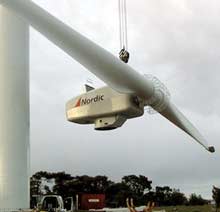Less May Be More for Wind Turbines
One of the first R&D grants to a renewable-energy developer from the economic-stimulus funds approved by Congress this spring could have a dramatic impact on the design of wind turbines. The $16 million loan guarantee offered by the U.S. Department of Energy (DOE) to Berkeley, CA-based Nordic Windpower will accelerate commercialization of the company’s Swedish-designed, two-bladed wind turbines, marking the first utility-scale alternative to the industry’s dominant three-bladed design in over a decade.

In recent years, wind-energy entrepreneurs have already been pushing beyond the standard design. Blue H Technologies of the Netherlands and Norway’s SWAY, for example, are testing unorthodox turbine designs tailored for placement on offshore platforms anchored in deep water far offshore. Blue H is testing two-bladed turbines akin to Nordic’s, while SWAY has a three-bladed design that faces the rotor downwind, bucking the industry’s conventional into-the-wind orientation.
The attraction for all three companies to pursue innovative approaches is essentially the same: their designs could be substantially lighter than today’s turbines, and could thus produce energy at much lower cost. That remains an important goal for wind power, which, though presently the cheapest form of renewable-power generation, remains dependent on government incentives.
What sets Nordic apart from others rethinking wind-turbine architecture is that its prototypes have been operating successfully for over a decade. Backed by Goldman Sachs since 2007 and now by the DOE, the company plans to begin shipping commercial models later this year. Nordic’s experience should help overcome skepticism that such alternative designs can be robust in megawatt-scale machines–skepticism that was reinforced by earlier, failed experiments with two-bladed and downwind turbines.
Nordic Windpower CEO Tom Carbone, who formerly led the U.S. operations of Danish wind-turbine giant Vestas, says that Nordic’s key technology is the “teetered hub” that the two blades use. Nordic’s hub provides a flexible link between the rotor and the generator driveshaft, enabling the blades to move in and out of the plane of rotation in response to gusts or turbulence. Carbone says Nordic’s lightweight design can deliver a whopping 20-25 percent cost reduction relative to three-bladed turbines.
Bumpers constrain the hinging to just two degrees in either direction, but that is enough to shed unwanted forces that would otherwise strain the turbine’s gearbox. Shedding unwanted forces also means that the entire structure, from tower to generator to blades, can be built lighter and cheaper. “You’re reducing the amount of material normally used to strengthen the structure against those loads,” says Carbone.
Delivering on the promise of savings, however, is harder than it sounds. Nordic’s design, Carbone says, “is pretty simple in function. It’s a just a hinge that’s perpendicular to the rotor. But perfecting that simplicity took a lot of time and effort.”
Larry Miles has spent the last decade trying to develop a flexible two-bladed wind turbine with individually hinged blades. Miles’s Wind Turbine Company, based in Bellevue, WA, was preparing to push a 500-kilowatt prototype of its hinged-blade turbine to 750 kilowatts when a control-system error allowed one blade to swing too far and strike the tower. The resulting damage ultimately caused the DOE to withdraw support for the firm’s research program.
Carbone says that such setbacks have not tarnished Nordic because its teetered design is already well proven. Since the mid-1970s, the Swedish government has poured close to $75 million into Nordic’s Swedish predecessor, producing a string of prototypes. Four of the five one-megawatt turbines Nordic has installed since 1995 are still running, demonstrating an average mechanical reliability of 98 percent. “We can catapult off that experience and use today’s control [systems] and materials to make an even better product,” says Carbone.
Nordic’s plan is to first validate its design by selling turbines to community-scale wind-energy developments with up to 20 turbines–projects that are too small to support a dedicated maintenance staff and therefore need reliability. Nordic says it already has orders for 19 turbines for small installations at a military base in Arizona, a housing development in Minneapolis, and a power project in Uruguay. The primary use of the DOE loan guarantee will be expansion of the company’s assembly plant in Pocatello, ID.
Carbone says Nordic will ramp up carefully to assure reliability and customer satisfaction before engineering its next step: a 2.5- to 3-megawatt turbine to compete for use by large, utility-scale wind farms. “In 2012 we will prototype a 2.5 to 3-megawatt machine, which will take us to a $1 billion company in roughly seven years from now,” promises Carbone.
Miles estimates that the savings from Nordic’s design might be closer to 10 percent. But Miles says that could still make an important difference: “If their machine works reliably, they’re going to have a definite cost advantage over a three-blade machine.”
Keep Reading
Most Popular
Large language models can do jaw-dropping things. But nobody knows exactly why.
And that's a problem. Figuring it out is one of the biggest scientific puzzles of our time and a crucial step towards controlling more powerful future models.
How scientists traced a mysterious covid case back to six toilets
When wastewater surveillance turns into a hunt for a single infected individual, the ethics get tricky.
The problem with plug-in hybrids? Their drivers.
Plug-in hybrids are often sold as a transition to EVs, but new data from Europe shows we’re still underestimating the emissions they produce.
Stay connected
Get the latest updates from
MIT Technology Review
Discover special offers, top stories, upcoming events, and more.